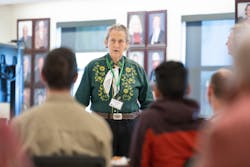Dr. Temple Grandin Shares Insider Tips on Designing for Neurodiversity
Interview conducted by Lauren Brant
Dr. Temple Grandin ever so famously offered up one of the first inside narratives from an autistic mind, paving the way for children and adults who are also on the spectrum to lead happy, productive and successful lives. We were lucky enough to sit down with her in between a very busy travel schedule to get her dos and don’ts on how to create productive learning environments for those who might experience both visual and auditory processing problems and ways to support the three “types” of thinkers.
i+s: How can interior designers start thinking in different ways when it comes to specifying products that take sensory sensitivities into account?
TG: One of the most important things to consider is LED lights that do not flicker. I cannot tell you how important that is. I learned from a lighting contractor that one way to determine if a light flickers is to take slow motion video. It has a very fast shutter speed, and it picks up the flicker. You will find the ones that do—and it’s not always the cheapest ones. It can sometimes be due to a dimmer switch. Some flat-screen TVs also flicker. Laptops and tablets do not flicker.
This problem will bother maybe 10-20% of autistics, 10-20% of dyslexics and 10-20% of those who suffer from head injuries. Most people cannot see it (I cannot see it). The old-fashioned fluorescent lights flickered, but they’re being phased out. I had a student that had this problem, and she said the room was like a strobe light.
i+s: Oh wow. Well, how do you focus with that then?
TG: Well, you can’t. Sunlight can help the problem if a student or employee can be placed near a window; or get a lamp with an LED bulb (that doesn’t flicker of course, use the phone trick) to block out the one that does flicker. That’s the single most important thing that could be done architecturally—the other is to avoid high-contrast stripes (particularly vertical) and checkerboards. Some people with visual processing problems can see the stripes vibrate. These are the same people that when they go to read can see the print jiggle. Try printing on light blue, light tan or light grey paper, or try changing fonts or the background on the computer—they have to pick out the color that’s right for them. But that can remove the vibration and then they can read. This is only a subgroup, keep in mind.
i+s: What do you see as some of the major issues today with the design and construction of schools?
TG: Lighting is number one. Noise abatement and sound-absorbing materials are also important in larger open areas—lunchrooms, lobbies, areas with lockers. If you can somehow allow children to control the noises that bother them, it might allow them to eventually tolerate it. Same goes for movement—some kids can’t stand rapid movement; others love it. For example, if a child can’t stand automatic doors, let them play with it or initiate the use.
i+s: What about furniture?
TG: Some people on the spectrum need a place to relax and be calm—a room with softer furnishings and more basic elements. They need to take sensory breaks. Enclosed pods and/or phone booths can be helpful, as can cubicles with higher walls or partitions.
i+s: They need somewhere, where there’s nothing overwhelming then?
TG: That’s right.
i+s: And what role does layout play?
TG: You’d want to avoid any open plans where you can hear everyone’s conversations. Integrating outdoor space and access to natural lighting is vital, too. But that’s good for everyone, so as you can see neurodiverse and typical people aren’t very different on a lot of this stuff, so don’t feel like you’re totally constrained as a designer. As long as flickering lights and high-contrast stripes and checkerboards are avoided, you’ve got a lot of flexibility.
i+s: What do you want educators to know about the different types of thinkers you outline in your book and how they process information differently?
TG: I’m an object visualizer. People like me just see pictures. I can look at a drawing of a building and visualize it. For a verbal thinker that’s useless. They need a full-color, 3D model, rendering or animation for them to see it.
Visual spatial thinkers excel in pattern recognition and systemic thinking. I spoke with a student last night who’s very mathematically inclined, so if you’re talking about a stack of apples at the grocery store, while I’m seeing that in my head, he’s making a geometric pyramid or shape of the apple stack.
To learn more about the different types of thinkers, read Dr. Grandin’s book, Visual Thinking: The Hidden Gifts of People Who Think in Pictures, Patterns and Abstractions, available at templegrandin.com.
About the Author
Lauren Brant
Editor, i+s and BUILDINGS
Lauren Brant is the editor at both i+s and Buildings. She is an award-winning editor and reporter whose work appeared in daily and weekly newspapers. In 2020, the weekly newspaper won the Rhoades Family Weekly Print Sweepstakes—the division winner across the state's weekly newspapers. Lauren was also awarded the top feature photo across Class A papers. She holds a B.A. in journalism and media communications from Colorado State University-Fort Collins and a M.S. in organizational management from Chadron State College.

